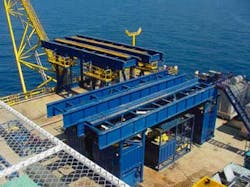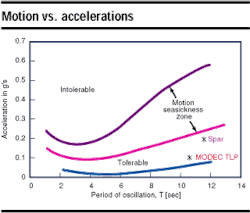DRILLING TECHNOLOGY: Mini-TLP plus dynamic rig kit allows more flexibility on Prince Project
As the offshore oil and gas industry strives to exploit reserves off the shelf, the high cost of doing business in deepwater prohibits commercialization of many smaller plays. Bringing together new technology to lower operator costs (development and operations costs) in deepwater projects is vital to continued offshore development.
This article focuses on two recent innovations related to new technology in platform and rig design for deepwater applications: reducing operator costs and enhancing deepwater rig availability, and emerging competition between deepwater platform suppliers.
El Paso Production Company and its sister company, Argo, LLC, are currently completing development of the Ewing Bank Block 1003 production unit (Prince Project) using a small, multi-purpose tension leg platform (mini-TLP) in 1,490 ft water depth. The TLP is an eight-tendon moored facility, with a nominal 15,000-ton displacement hull and a three-level deck equipped for full processing of 50,000 b/d of oil and 80 MMcf/d of natural gas.
The oil and gas produced and processed at the facility are exported via departing 12-in. oil and 12-in. gas pipelines. The facility is also designed for future subsea development opportunities.
Project planning was initiated in April 2000, when permitting, finalizing design, and contracting and fabricating the hull, facilities, and pipelines began. Well engineering and completion operations were developed concurrently using a conventional Nabors Offshore Super Sundowner completion rig. In April 2001, the two pipelines and TLP piles were installed. The hull, tendons, and deck were mated in July, and the completion rig was installed in August. First production occurred on September 26, 2001.
Initially, four wells will be produced on the TLP. These wells were directionally drilled from a cluster location using semisubmersible drilling units. The four subsea wellheads are located in a close proximity to one another at the TLP installation site. The wells are 15,000 ft geopressured oil wells equipped with 9-5/8-in. production casing. The subsea wells have been tied back to the TLP using concentric dual barrier production risers and are being completed using high rate, gravel pack completions. The wells are equipped with 3.5-in. production tubing.
Rig of opportunity
Application of the "rig of opportunity" concept significantly benefited the Prince Project. Nabors Offshore Corporation has eight 1,000 hp, modular platform rigs - Super Sundowner units - all constructed to similar specifications with components that are basically interchangeable. The rigs have been used on fixed platforms for drilling and workover operations. The drilling contractor developed a kit to allow the rig's mast and substructure to withstand the dynamic forces associated with use on both TLPs and Spars.
This technology made it possible to install a rig on the Prince TLP without having to resort to a purpose-built rig or to placing a rig on standby to meet the project schedule and timing.
Two export pipelines were installed for transporting oil and gas from the TLP. Gas is exported via a 12-in. line to the El Paso Energy Partner's South Timbalier Block 292 platform about 14.2 miles north-northwest of Prince. At this point, the gas enters the Manta Ray Offshore Gas Pipeline System. Oil is exported via a new 8.8-mile-long, 12-in. oil line connecting with the Poseidon's 16-in. pipeline at a location in Ewing Banks Block 873. Strategically, these pipelines extend El Paso's pipeline system into the deepwater Gulf of Mexico.
Changing technology
Platform rigs have a significant impact on the design and construction of Spars and TLPs in dry tree applications. The largest impact on loading involves the rig during worst-case combined drilling loads of some aspect of the drilling operation. Any weight saved on the rig structure and components of the rig typically reduces the amount of the floating platform's buoyancy requirements by three times the amount of rig weight saved.
The savings from this payload can be as high as $4-$6/lb. of payload. This large capital expense savings can be passed on to the owner of the floating structure and ultimately to the lease operator. Saving weight in rig design has obvious implications.
But simply emphasizing efficient design features does not make the rig economical. In this stage of deepwater growth, availability plays a key role in economics. Designing the most weight-efficient rig may reap economic rewards, but it can only work on one project at a time.
With growth in this industry as it is today, the problem of rig availability must be addressed. Should new purpose-built rigs be constructed at high cost and high saturation risk? Yes, if necessary, but finding the means to modify what is available through economically innovative methods achieves greater economic efficiencies for large deepwater shareholders such as platform owners and operators.
Creating flexibility
In order to meet the needs for lighter capacity on completion and drilling projects, Nabors Offshore developed a dynamic conversion kit for its 1,000 hp Super Sundowner modular platform rigs. This small fleet of eight 400-kip hoisting capacity was converted to meet Spar and TLP acceleration criteria. Two of these rigs with new kits are working in the Gulf of Mexico, one for Conoco on the Jolliet tension leg well platform (TLWP) in 1,760 ft water depths on Green Canyon 184, and the other for El Paso Production on its Modec-designed Prince mini-TLP. Both rigs are working triples on the two deepwater platforms.
With the two kits, any one of the eight rigs can be deployed on a Spar or TLP. When the deepwater project is completed, the rig sheds the kit and goes back to working static platforms. The commissioning to ready a rig is minimal.
The kit concept replaces dumb metal on the modular rig with reinforced modules. New strongbacks, a drillfloor, and rig support tanks replace modular components of the existing statically designed rig. The mast is fit with a Loadmaster Engineering, Inc. telescoping support structure that adds four pin connections to the existing mast.
The substructure components were modeled by Zentech Engineering to allow for acceleration forces up to 0.4 g. This includes the option of hanging the original rig mud tanks from the strongbacks if space limitations preclude positioning the tanks on the deck. If the rig has already worked a floating platform project, it simply picks up the kit and goes to work.
Commissioning of a non-converted Super Sundowner involves adding pin connections to the existing mast and comparing mast stability to acceleration requirements for reinforcements. The only other rig component requiring reinforcement is the drawworks roof, with very minor tubing stiffeners.
The remaining modular components, such as the rig baskets containing all the functioning components of the rig, remain the same. Attaching the new rig support trusses to the various skidbeam configurations requires custom clamps or modification to clamps used on previous deepwater platform projects. A high degree of efficiency is built into quick rig-up time and low component weight. The same efficient modularity design was put into the dynamic kits.
TLPs versus Spars
Although FPSOs and semisubmersibles have been utilized for deepwater developments in the international arena for wet tree solutions, the Gulf of Mexico deepwater projects have utilized two basic types of floating drilling platforms to provide the direct vertical access option - Spars and TLPs.
Emerging competition between the Spar and the TLP concepts is increasing. For example, Modec's fourth generation TLP design (Moses) expands the water depth range of application for TLPs to 6,000 ft. In addition, the number of Spar suppliers continues to grow.
As part of the scope of work for the Prince Project, the Moses TLP had to be designed to be able to be moved to 6,000 ft water depth. The favorable motion characteristics of this TLP design, coupled with its lower cost and deeper water capability allowed this TLP concept to expand the range of applicability where the TLP can compete commercially with the spar concept.
The concept selection process for determining the best option for a given field development is difficult and time consuming. Cost is the most significant factor and varies with market conditions and contractor backlogs. However, other aspects also need to be considered, especially when the normalized cost of each concept is close.
Motion and acceleration
The Spar and TLP concepts have very different motion characteristics and impart different acceleration forces to top deck equipment such as workover/drilling rigs and process equipment. In general, the Modec Moses TLP has lower accelerations than the Spar. For Moses, the peak lateral acceleration of the deck is about 20% of gravity, compared to upwards of 40% for Spar designs. This reduces the lateral loads on the TLP deck and produces a more efficient deck design, which thereby increases available payload for the platform. The reduced lateral acceleration also improves performance of personnel, process equipment, and drilling rig operations.
Also, in general, the Moses unit has favorable motion characteristics, compared with a Spar. In a 100-year storm, the vertical motion of a Spar is about 20 times greater. At the riser keel joint, the relative motion of the Spar hull and riser is 4.2 ft, plus the additional set-down of the riser due to offset. This riser set-down can be over 10 ft in 4,500 ft water depth, producing a relative motion of over 14 ft between the Spar hull and the riser. The Moses unit has virtually no relative motions between hull and riser at the keel joint.
Additionally, the maximum pitch angle of the Spar is about 30 times that of the Moses unit. This large pitch angle causes high deck lateral acceleration at the top of the spar. This acceleration imposes larger deck loads and thus results in a heavier deck for the spar concept.
Unique characteristics
Moses is different from other TLPs in that it has a lower platform vertical center of gravity (VCG) position, which when combined with small hull columns contributes to reduced "higher order" loading effects. Higher order effects manifest as "springing" and "ringing" loads in the tendons, which are short period tendon tension variations due to resonant motions of the TLP hull.
For the Prince Moses design, these effects represent about only 25% of the tendon wave frequency load. Large column TLPs generally have higher order loads that are a significantly larger percentage of the tendon wave frequency loads. Some are somewhere upwards of 70% of the wave frequency loads. This is one aspect that allows the Modec unit to be competitive in greater water depths. These motion characteristics result in a more tolerable situation for personnel on board the Modec TLP.
Acknowledgement
SEA Engineering Associates of Houston contributed to this article.
Authors
Bob Smith is a consultant to El Paso Production Co. He is coordinating El Paso Production Company's Prince TLP completion activities. He holds a BS in Petroleum Engineering from Colorado School of Mines and has worked in the oil and gas industry for the past 42 years.
Greg Carter is an Engineering Manager at Nabors Offshore Corporation. He is involved with engineering and operations of various rig types, including platform rigs, barge rigs, and jackups. He holds a BS in Engineering from Texas A&M and an MBA from Houston Baptist University. He is a registered Professional Engineer in Texas and has been involved in the offshore oil and gas industry for 20 years.
Ray Koon is Vice President of Projects and Engineering for Modec International. He is responsible for the design, fabrication, and installation of Modec International projects including TLPs, FPSOs, and FSOs. He holds a BS in Engineering from New Mexico State University, is a registered Professional Engineer in Texas, and has been involved in the offshore oil and gas industry for 31 years.



